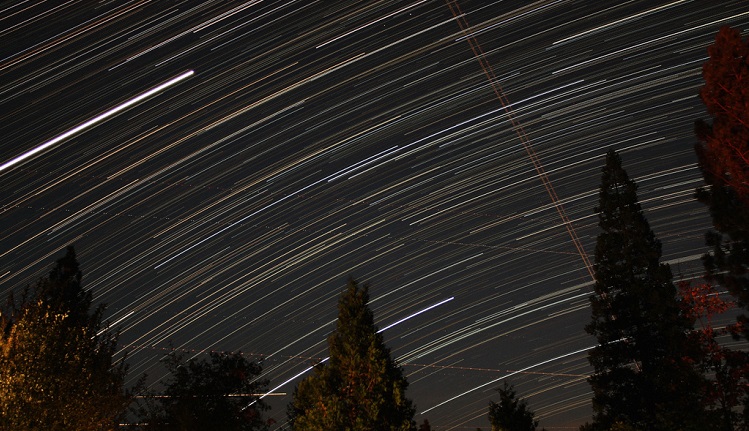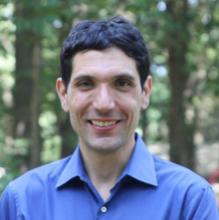The Fabric Of Reality May Be 'Spookier' Than We Imagine, New Book Argues

Nick Ares via Flickr | http://bit.ly/1iI4N68
(Inside Science, Currents) -- I’m questioning some basic assumptions about the nature of reality after reading "Spooky Action at a Distance," a new book written by my friend and colleague George Musser. I join many others in regarding Musser as one of the best science writers covering cutting-edge physics research. (As an additional disclosure, he belonged to an American Institute of Physics committee that advised Inside Science.) His book contains fascinating, mind-expanding ideas, and I’ve been thinking about them for days on end.
By synthesizing many state-of-the-art ideas in physics research, Musser presents a highly plausible argument that our perception of space may be an illusion. By space, I don’t just mean outer space, but the entire world around us, including the three dimensions of your bedroom, the colorful landscape outside your window, and the distance between your home and workplace. Yes, your commute may fundamentally be an illusion, according to these emerging theories. It still may take time and energy to get to where you need to go, but what you see outside your car window may not be quite as it appears.
This kind of radical rethinking is not unprecedented. We went through a similar situation with gravity. In Isaac Newton's picture of gravity, one even he found troubling at the time, two objects such as the Earth and the sun pulled at each other even though they were separated by great distances: it was as if they were exerting invisible force fields on one another. In Einstein's much different picture of gravity, the sun's mass bends the fabric of the solar system like a bowling ball on a canvas. Earth and the other planets roll around this distorted canvas, producing the still-convincing illusion that their orbits are caused by an invisible force field.
Knowing that history, it's not a surprise that physicists are reimagining the concept of space. But it's still shocking to read Musser's explanation that it may not fundamentally exist. The book quotes Caltech cosmologist and writer Sean Carroll, who said, "Space is totally overrated…totally bogus. Space is just an approximation that we find useful in certain circumstances."
While I remain at least a little skeptical — space seems to work pretty darned well in describing the universe around us — the book presents thought-provoking arguments to reconsider the fabric of reality. There are enough anomalies in the universe to give me pause. And as Musser points out, Albert Einstein was one of the first to have pinpointed them.
In the 1930s, Einstein used the term "spooky action at a distance" to describe a possible consequence of quantum mechanics. In the then-emerging description of the submicroscopic world, two particles separated at birth — created from a process such as the decay of an atom — can continue to affect each other even if they travel to opposite sides of the universe. They would be able to influence each other even faster than light could travel between them. A skeptical Einstein coined the "spooky" expression to critique what he saw as this strange prediction of quantum mechanics. He thought that a more complete theory of nature would rule out this apparent violation of the ultimate speed limit, the speed of light. However, experimenters have since confirmed that this "spooky action" — more properly known as "quantum entanglement" — really happens.
Now, physicists at the cutting edge are increasingly finding that this kind of spookiness may describe reality even more than the famous physicist may have imagined, affecting our deepest notions about space.
The distance between objects — or their close proximity — may all be illusory, according to the research that Musser describes in his book.
Recently, physicists discovered that it is much easier to calculate the outcomes of super-complicated multi-particle decays if you don't worry about the local space around them. Previously, physicists (and graduate physics students) would painstakingly analyze each particle's neighbors in these decays, but if you ignore their apparent configurations in space, you can get the same correct answers more easily.
And then there is the white whale of physics — the black hole. An intense subject of study, these objects may hold clues about many things including entanglement. Black holes swallow matter voraciously, but where does it go? Even though current theory suggests that the center of a black hole contains a completely unintuitive feature — a point of infinite density known as a singularity — physicists know they're missing something about black holes. Could our concept of space as a storehouse for matter be part of the problem?
Musser points out that one black hole with twice the mass of another black hole should be eight times as big, just as blowing up a balloon to twice its radius makes it eight times as big. But a black hole with twice the radius only appears to have two times the mass, possibly meaning that it is storing less matter than expected. This suggests numerous possibilities, such as matter going elsewhere in the universe — or maybe some aspect of its outer appearance is illusory. Fortunately, the behavior of a black hole at its outer surface — the event horizon — seems to be a fertile ground for understanding the entire black hole and discovering new physics. And that brings us to what may really be going on with space.
Just as the outer surface of the black hole could explain what is happening in its interior, the "holographic universe" theory suggests that the interior of our universe may be described by understanding the physics of the universe's edge, which, unfortunately, we cannot access. As an analogy, imagine if we could understand absolutely everything going inside the Earth by understanding the behavior of its surface. The Earth is three dimensions, but its surface is described by two dimensions — latitude and longitude. Similarly, the boundaries of the observable universe would have one fewer dimension than the universe's interior, but could perhaps completely explain its workings, according to the holographic principle.
Along similar lines, in Musser's book, philosopher Jenann Ismael wonders if the universe is like a kaleidoscope, in which light hits individual objects and bounces off mirrors to create multiple identical images. Maybe the entanglement that occurs between two particles at great distances is really, at a more fundamental level, the projection of a single thing onto what we perceive as two points in space.
So could space indeed be an illusion? We have assumed that space is a fundamental ingredient of reality, like a canvas for a painting. The recently proposed, but still rudimentary, theory of "quantum graphity" (a punny mashup of quantum gravity and graph theory) attempts to combine quantum mechanics and gravity by ignoring space, and simply exploring the relationships between basic objects known as "grains," which are stand-ins for fundamental constituents such as matter. Grains can form a network of connections with other grains; one grain can interact with another if they have enough energy. What we perceive as physical distance would actually be the amount of energy needed for two objects to interact.
What is my take on all this? Speaking as a science writer who has covered a lot of physics research, but without a Ph.D. in physics, I nonetheless have a few reservations. Space does a monumentally great job in helping us understand reality. I worry about throwing out valid assumptions about space in attempts to accommodate some important cases. Phenomena such as black holes and entanglement are very important, but they seem to represent special and uncommon exceptions in the universe, and not the majority of what is present or happening. As an example, physicists are struggling to build a quantum computer because it's hard to entangle more than a dozen atoms for just a short period of time. A pervasive effect called decoherence, not covered in Musser's relatively brief book, frequently spoils the effects of entanglement before particles can do anything spooky.
On the other hand, there are major unresolved issues in the universe, including how particles can seemingly communicate faster than light. So maybe we need a larger theory to explain everything. In the case of gravity, the illusion of the sun pulling the Earth and planets works well for most purposes, even in science. You basically only need Newton's laws to land on the moon. But when you want to explain subtleties like the weird movements of Mercury around the sun, which cannot be resolved by Newton's equations, you need Einstein's general relativity.
If space isn't what it seems, then what is it? My best analogy would be a group of kids playing "Minecraft" on different computers. They may perceive that they are building a beautiful 3-D house together, one they can all see, but what fundamentally is happening is that they are providing inputs into their computer, and receiving outputs from it. The house really doesn't exist — what is fundamentally happening is just a series of inputs and outputs on their computers.
Alternatively, imagine being in Star Trek's holodeck, a chamber in which projected images provide the illusion of 3-D reality. The holodeck seems completely real for those in it and the Star Trek characters have valid experiences in it. But it's actually an illusion. So while the holodeck experience is completely valid for those immersed in it, the larger reality is that something else is going on.
So it's an open question as to whether your commute may just be a matter of having enough energy and time to get to work — and may not involve space at all. Maybe it is time for all of us to give space a second thought — Musser's book will certainly encourage you to do so.

